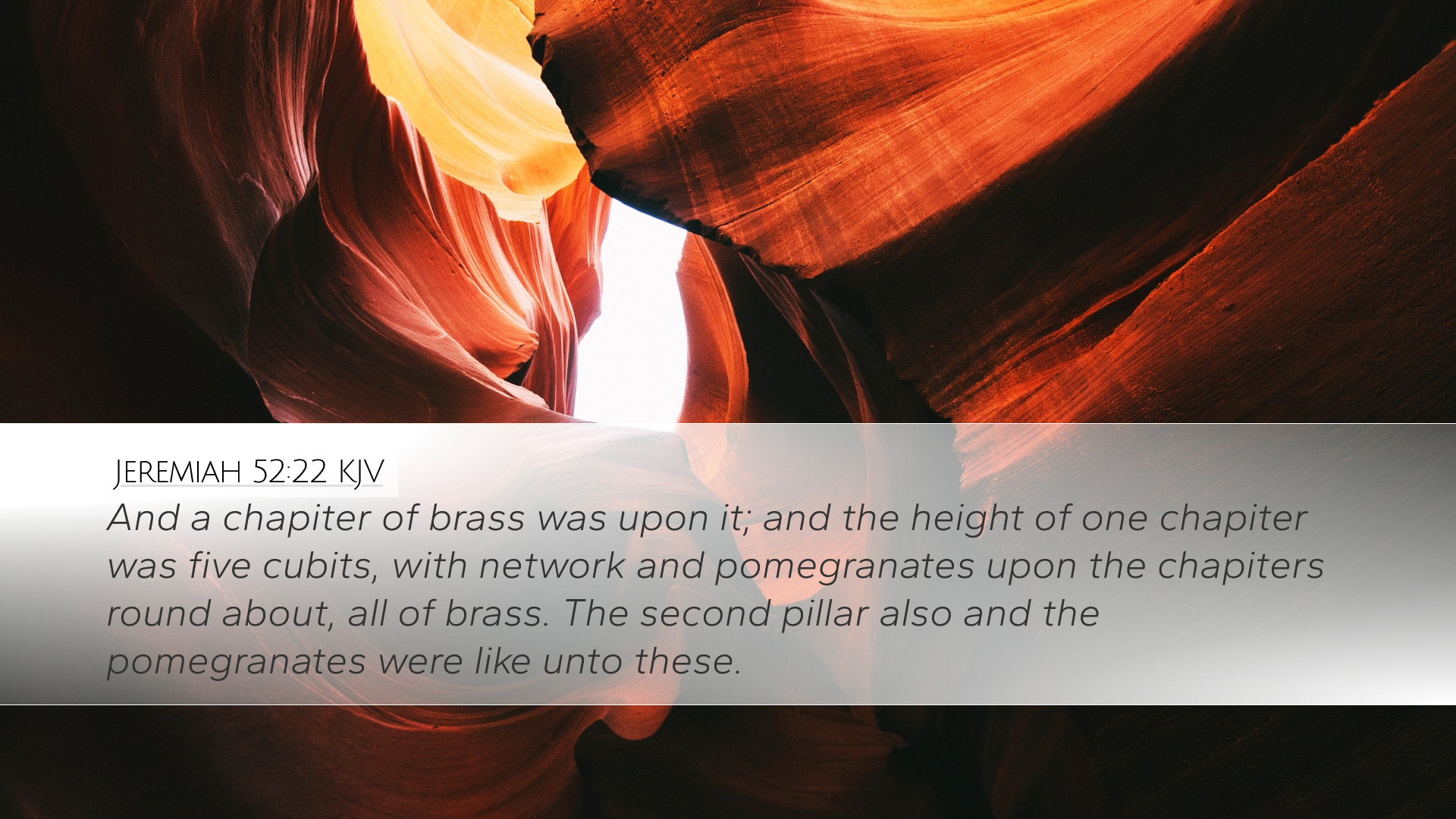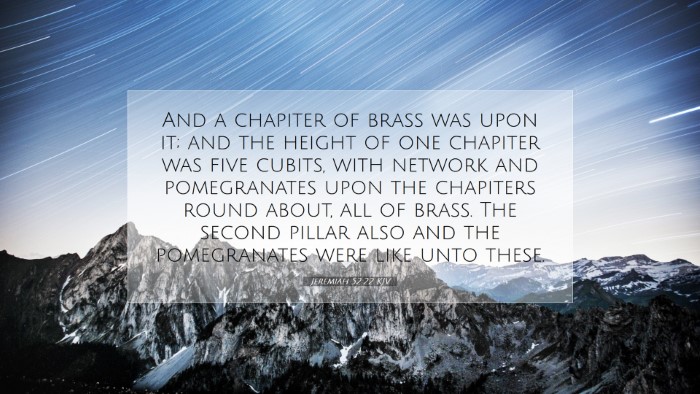Commentary on Jeremiah 52:22
Jeremiah 52:22 states: "And a pillar of brass of twenty cubits high was in the house of the Lord, and the little chapiter upon it was brass: and the length of the little chapiter was three cubits; and the wreaths and pomegranates upon the little chapiter round about, all of brass: and like unto these had the second pillar with wreaths.
This verse serves as a conclusion to the descriptions of King Zedekiah’s reign and the subsequent fall of Jerusalem. The details regarding the pillars in the Temple reflect not only architectural significance but also deep theological meaning.
Architectural Significance
According to Matthew Henry, the pillars mentioned represent stability and strength, symbolic of the house of God. In the Temple's construction, they have a dual role—they provide structural support and symbolize the presence of God among His people.
Albert Barnes points out that the brass indicates durability and resistance to decay, which metaphorically suggests God’s eternal nature, and His promise of preservation despite the impending calamities Israel would face.
Adam Clarke elaborates that the height of the pillar and its physical prominence signify the lofty nature of divine authority and worship. It reinforces the idea that the Temple was not just a building but a locus of divine interaction and revelation.
The Symbolism of the Pillars
- Stability and Strength: The pillars symbolize the stability of faith in God, even amidst the chaos surrounding Jerusalem.
- God’s Eternal Presence: Brass, as a material, represents the divine permanence and fidelity to His covenant.
- Wreaths and Pomegranates: These motifs signify abundance and fertility, serving as metaphors for the blessings that God bestows upon His people when they remain faithful.
Historical Context
The historical backdrop is vital for understanding this verse. As noted by Matthew Henry, the fall of Jerusalem heralded a significant shift in the spiritual landscape of Israel. The description of the Temple suggests a period of both glory and impending destruction. Historically, the pillars served as beacons of hope and reminders of God’s authority.
Albert Barnes reflects that, despite the imminent destruction, these descriptions remind the reader of what was lost—glory, divine presence, and national identity tied to the Temple.
Theological Insights
From a theological perspective, Jeremiah 52:22 illustrates the tension between divine judgment and mercy. Adam Clarke posits that the detailed description of the Temple's pillars allows us to appreciate God’s holiness and His justice. Though the people of Israel face judgment, God’s covenant remains—a thread of hope woven within their story.
This serves as a poignant reminder for scholars and theologians today of the interceding nature of God, even in times of adversity. From the perspective of Matthew Henry, there is an underlying message—that the Church, like the Temple, must stand firm in its faith, embodying strength and resilience in the face of societal chaos.
Application for Today
Pastors and leaders can draw practical insights from this passage. The emphasis on the pillars as symbols of strength and permanence encourages the modern church to establish roots in God's Word and to remain steadfast in faith. Albert Barnes encourages believers to reflect on their foundations, calling them to examine whether they are built upon the solid rock of Christ.
Adam Clarke suggests that for contemporary believers, the imagery of the Temple encourages a deeper appreciation for the significance of corporate worship and the shared faith community, which mirrors the unity that the pillars represented in ancient times.
Conclusion
In summary, Jeremiah 52:22 not only serves as a historical reminder of the past glory of God's dwelling but also offers timeless lessons regarding faith and resilience. The pillars symbolize not just physical attributes but serve as profound reminders of God's unwavering presence, authority, and the hope found in His promises amid challenges.
For pastors, students, and theologians, this passage provides a rich foundation for exploring God's character, inspiring faithfulness, and cultivating a resilient spirit through trials, while also reflecting on the necessity of maintaining a close, abiding relationship with the Lord.


